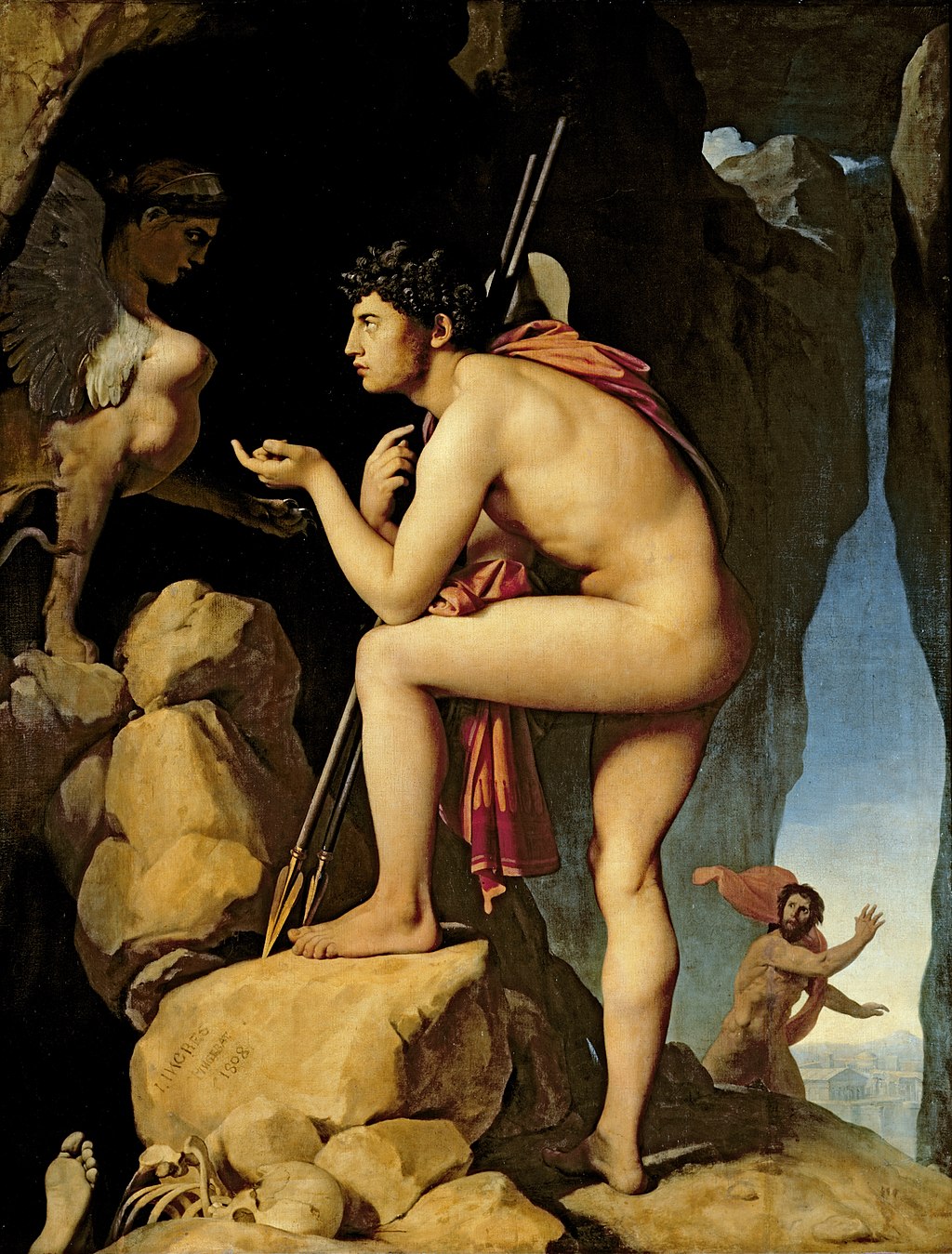
オイディプス
Oedipus

Oedipus describes the riddle of the Sphinx by Jean-Auguste-Dominique Ingres, c. 1805
☆ オイディプス(UK: /ˈiːpəs/, US: /ːdɪ, ˈɛδίπους 「腫れた足」Oedipus)は、神話に登場するギリシャ神話のテーベの王である。ギリシャ神話における悲劇のヒーローであるオイディプスは、父親を殺して母親と結婚す るという予言を成就させ、それによって彼の都市と家族に災いをもたらす。ジークムント・フロイトの「オイディプス・コンプレックス」により、世界的に有名になったギリシャ悲劇のヒーロー。
|
Oedipus Oedipus (UK: /ˈiːdɪpəs/, also US: /ˈɛdə-/; Greek: Οἰδίπους "swollen foot") was a mythical Greek king of Thebes. A tragic hero in Greek mythology, Oedipus fulfilled a prophecy that he would end up killing his father and marrying his mother, thereby bringing disaster to his city and family. The story of Oedipus is the subject of Sophocles' tragedy Oedipus Rex, which is followed in the narrative sequence by Oedipus at Colonus and then Antigone. Together, these plays make up Sophocles' three Theban plays. Oedipus represents two enduring themes of Greek myth and drama: the flawed nature of humanity and an individual's role in the course of destiny in a harsh universe. In the best-known version of the myth, Oedipus was born to King Laius and Queen Jocasta of Thebes. Laius wished to thwart the prophecy, so he sent a shepherd-servant to leave Oedipus to die on a mountainside. However, the shepherd took pity on the baby and passed him to another shepherd who gave Oedipus to King Polybus and Queen Merope to raise as their own. Oedipus learned from the oracle at Delphi of the prophecy that he would end up killing his father and marrying his mother but, unaware of his true parentage, believed he was fated to murder Polybus and marry Merope, and so he left for Thebes. On his way, he met an older man and killed him in a quarrel. Continuing on to Thebes, he found that the king of the city (Laius) had recently been killed and that the city was at the mercy of the Sphinx. Oedipus answered the monster's riddle correctly, defeating it and winning the throne of the dead king – and the hand in marriage of the king's widow, who was also (unbeknownst to him) his mother Jocasta. 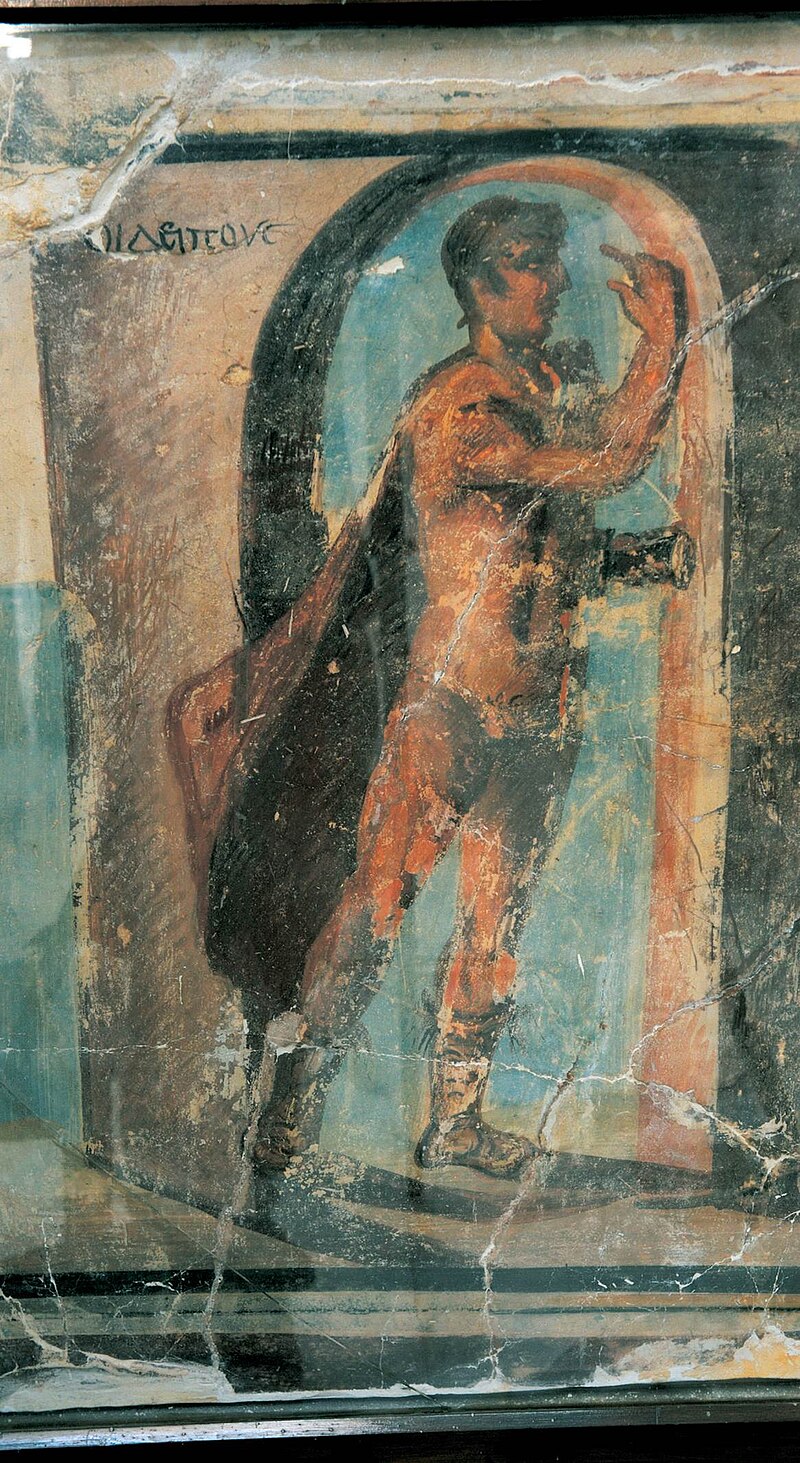 Detail of ancient fresco in which Oedipus solves the riddle of the Sphinx. Egyptian Museum, 2nd c. CE Years later, to end a plague on Thebes, Oedipus searched to find who had killed Laius and discovered that he himself was responsible. Jocasta, upon realizing that she had married her own son, hanged herself. Oedipus then seized two pins from her dress and blinded himself with them. The legend of Oedipus has been retold in many versions and was used by Sigmund Freud to name and give mythic precedent to the Oedipus complex. |
オ
イディプス/エディプス オ イディプス(UK: /ˈiːpəs/, US: /ːdɪ, ˈɛδίπους 「腫れた足」)は、神話に登場するギリシャ神話のテーベの王である。ギリシャ神話における悲劇のヒーローであるオイディプスは、父親を殺して母親と結婚す るという予言を成就させ、それによって彼の都市と家族に災いをもたらした。 オイディプスの物語は、ソフォクレスの悲劇『オイディプス王』の主題であり、それに続く物語として『コロノスのオイディプス』、そして『アンティゴネー』 がある。これらの戯曲を合わせると、ソフォクレスの3つのテーバン劇となる。オイディプスは、ギリシア神話と戯曲の不朽のテーマである人間の欠陥と、過酷 な宇宙における運命の流れの中での個人の役割の2つを象徴している。 最もよく知られている神話では、オイディプスはテーベのライオス王とジョカスタ王妃の間に生まれた。ライオスは予言を阻止しようと考え、羊飼いにオイディ プスを山の中腹で死なせるよう仕向けた。しかし、羊飼いは赤ん坊を憐れんで別の羊飼いに託し、その羊飼いはオイディプスをポリュバス王とメロペ王妃に渡し て自分たちの子として育てさせた。オイディプスはデルフィの神託で、自分が父親を殺して母親と結婚するという予言を知ったが、自分の本当の親を知らず、ポ リュバスを殺してメロペと結婚する運命だと信じ、テーベに向かった。テーベに向かう途中、年上の男と出会い、けんかの末に殺してしまった。さらにテーベに 向かうと、街の王(ライオス)が最近殺され、街はスフィンクスのなすがままになっていた。オイディプスは怪物のなぞなぞに正解し、怪物を倒して死んだ王の 王位を手に入れ、王の未亡人と結婚した。  オイディプスがスフィンクスの謎を解く古代のフレスコ画の詳細。エジプト博物館、紀元2世紀 数年後、テーベの疫病を終わらせるために、オイディプスはライオスを殺した犯人を探し、自分自身に責任があることを突き止めた。ジョカスタは、自分が自分 の息子と結婚したことに気づき、首を吊った。その後、オイディプスは彼女のドレスから2本のピンを奪い、それで自分の目をつぶした。 オイディプスの伝説は多くのバージョンで語り継がれ、ジークムント・フロイトによってオイディプス・コンプレックスと名付けられ、神話の先例とされた。 |
| Basics of the myth Variations on the legend of Oedipus are mentioned in fragments by several ancient Greek poets including Homer, Hesiod, Pindar, Aeschylus and Euripides. However, the most popular version of the legend comes from the set of Theban plays by Sophocles: Oedipus Rex, Oedipus at Colonus, and Antigone. Oedipus was the son of Laius and Jocasta, king and queen of Thebes. Having been childless for some time, Laius consulted the Oracle of Apollo at Delphi. The Oracle prophesied that any son born to Laius would kill him. In an attempt to prevent this prophecy's fulfillment, when Jocasta indeed bore a son, Laius had his son's ankles pierced and tethered together so that he could not crawl; Jocasta then gave the boy to a servant to abandon ("expose") on the nearby mountain. However, rather than leave the child to die of exposure, as Laius intended, the servant passed the baby on to a shepherd from Corinth, who then gave the child to another shepherd. The infant Oedipus was eventually adopted by Polybus and Merope, the king and queen of Corinth, as they were without children of their own. Little Oedipus was named after the swelling from the injuries to his feet and ankles ("swollen foot"). The word "oedema" (British English) or "edema" (American English) is from this same Greek word for swelling: οἴδημα, or oedēma. After many years, Oedipus was told by a drunk that he was a "bastard", meaning at that time that he was not their biological son. Oedipus confronted his parents (the king and queen of Corinth) with the news, but they denied this. Oedipus went to the same oracle in Delphi that his birth parents had consulted. The oracle informed him that he was destined to murder his father and marry his mother. In an attempt to avoid such a fate, he decided not to return home to Corinth, but to travel to Thebes, which was closer to Delphi. On the way, Oedipus came to Davlia, where three roads crossed. There he encountered a chariot driven by his birth-father, King Laius. They fought over who had the right to go first and Oedipus killed Laius when the charioteer tried to run him over. The only witness of the king's death was a slave who fled from a caravan of slaves also traveling on the road at the time. Continuing his journey to Thebes, Oedipus encountered a Sphinx, who would stop all travelers to Thebes and ask them a riddle. If the travelers were unable to answer her correctly, they would be killed and eaten; if they were successful, they would be free to continue on their journey. The riddle was: "What walks on four feet in the morning, two in the afternoon, and three at night?". Oedipus answered: "Man: as an infant, he crawls on all fours; as an adult, he walks on two legs and; in old age, he uses a 'walking' stick". Oedipus was the first to answer the riddle correctly; the Sphinx was so embarrassed that someone had solved her riddle that she killed herself by jumping off of a cliff; in some versions, however, Oedipus himself kills her. Queen Jocasta's brother, Creon, had announced that any man who could rid the city of the Sphinx would be made king of Thebes and given the recently widowed Queen Jocasta's hand in marriage. This marriage of Oedipus to Jocasta fulfilled the rest of the prophecy. Oedipus and Jocasta had four children: sons Eteocles and Polynices (see Seven Against Thebes) and daughters Antigone and Ismene. Many years later, a plague of infertility struck the city of Thebes, affecting crops, livestock, and the people. Oedipus asserted that he would end the pestilence. He sent his uncle, Creon, to the Oracle at Delphi, seeking guidance. When Creon returned, Oedipus learned that the murderer of King Laius must be brought to justice, and Oedipus himself cursed the killer of his wife's late husband, saying that he would be exiled. Creon also suggested that they try to find the blind prophet, Tiresias, who was widely respected. Oedipus sent for Tiresias, who warned him not to seek Laius' killer. In a heated exchange, Tiresias was provoked into exposing Oedipus himself as the killer, and the fact that Oedipus was living in shame because he did not know who his true parents were. Oedipus angrily blamed Creon for the false accusations, and the two argued. Jocasta entered and tried to calm Oedipus by telling him the story of her first-born son and his supposed death. Oedipus became nervous as he realized that he may have murdered Laius and so brought about the plague. Suddenly, a messenger arrived from Corinth with the news that King Polybus had died. Oedipus was relieved for the prophecy could no longer be fulfilled if Polybus, whom he considered his birth father, was now dead. Still, he knew that his mother was still alive and refused to attend the funeral at Corinth. To ease the tension, the messenger then said that Oedipus was, in fact, adopted. Jocasta, finally realizing that he was her son, begged him to stop his search for Laius' murderer. Oedipus misunderstood her motivation, thinking that she was ashamed of him because he might have been born of low birth. Jocasta in great distress went into the palace where she hanged herself. Oedipus sought verification of the messenger's story from the very same herdsman who was supposed to have left Oedipus to die as a baby. From the herdsman, Oedipus learned that the infant who was raised as the adopted son of Polybus and Merope, was the son of Laius and Jocasta. Thus, Oedipus finally realized that the man he had killed so many years before was his father and that he had married his mother. Events after the revelation depend on the source. In Sophocles' plays, Oedipus went in search of Jocasta and found she had killed herself. Using the pin from a brooch he took off Jocasta's gown, Oedipus blinded himself and was then exiled. His daughter Antigone acted as his guide as he wandered through the country, finally dying at Colonus where they had been welcomed by King Theseus of Athens. However, in Euripides' plays on the subject, Jocasta did not kill herself upon learning of Oedipus's birth, and Oedipus was blinded by a servant of Laius. The blinding of Oedipus does not appear in sources earlier than Aeschylus. Some older sources of the myth, including Homer, state that Oedipus continued to rule Thebes after the revelations and after Jocasta's death.[1] Oedipus's two sons, Eteocles and Polynices, arranged to share the kingdom, each taking an alternating one-year reign. However, Eteocles refused to cede his throne after his year as king. Polynices brought in an army to oust Eteocles from his position and a battle ensued. At the end of the battle, the brothers killed each other, after which Jocasta's brother, Creon, took the throne. He decided that Polynices was a "traitor", and should not be given burial rites. Defying this edict, Antigone attempted to bury her brother. In Sophocles' Antigone, Creon had her buried in a rock cavern for defying him, whereupon she hanged herself. However, in Euripides' lost version of the story, it appears that Antigone survives. |
神話の基本 オイディプス伝説のバリエーションは、ホメロス、ヘシオドス、ピンダル、アイスキュロス、エウリピデスなど古代ギリシャの詩人たちによって断片的に語られ ている。しかし、この伝説の最もポピュラーなバージョンは、ソフォクレスのテーバン劇一式に由来する: オイディプス王』、『コロノスのオイディプス』、『アンティゴネー』である。 オイディプスは、テーベの王ライウスと王妃ジョカスタの息子である。しばらく子供がいなかったので、ライオスはデルフィのアポロンの神託に相談した。託宣 は、ライオスとの間に生まれた息子はライオスを殺すと予言した。この予言が成就するのを阻止しようと、ヨカスタが本当に息子を産むと、ライオスは息子の足 首に穴を開け、這うことができないように繋ぎ合わせた。しかし、召使いは、ライオスの意図したように子供を放置して死なせるのではなく、コリントから来た 羊飼いに子供を渡し、その羊飼いはまた別の羊飼いに子供を渡した。 幼いオイディプスは、コリントの王ポリュスと王妃メロペの養子となった。小さなオイディプスは、足と足首を怪我して腫れたことから名づけられた(「腫れた 足」)。oedema」(イギリス英語)または「edema」(アメリカ英語)という単語は、この腫れを意味する同じギリシャ語のοἴδημα、つまり oedēmaからきている。 長い年月の後、オイディプスは酔っぱらいから「私生児」であることを告げられた。オイディプスは両親(コリントの王と王妃)にそのことを告げたが、両親は それを否定した。オイディプスは、実の両親が相談したのと同じデルフィの神託を受けに行った。神託は、オイディプスが父を殺し、母と結婚する運命にあるこ とを告げた。そのような運命を避けようと、彼はコリントに帰らず、デルフィに近いテーベに向かうことにした。 その途中、オイディプスは3つの道が交差するダヴリアにやって来た。そこで彼は、生みの親であるライオス王の駆る戦車に遭遇した。二人はどちらが先に行く 権利を持つかで争い、オイディプスは、戦車乗りがライオスを轢こうとしたところを殺してしまった。王の死を目撃したのは、そのとき同じ道を旅していた奴隷 のキャラバンから逃げてきた奴隷だけだった。 テーベへの旅を続けていたオイディプスは、スフィンクスに遭遇する。スフィンクスはテーベに向かう旅人をすべて呼び止め、謎かけをする。もし旅人がスフィ ンクスに正しく答えることができなければ、殺されて食べられてしまう。なぞなぞはこうだった: 「朝は4本足、昼は2本足、夜は3本足で歩くものは何か?オイディプスは答えた: 「幼児期には四つん這いになり、大人になると二本足で歩き、老年期には杖を使う」。オイディプスが最初に謎に正解したが、スフィンクスは謎を解かれたこと を恥じて崖から飛び降り自殺した。 ジョカスタ王妃の兄クレオンは、スフィンクスの謎を解くことができた者をテーベの王とし、最近未亡人となったジョカスタ王妃と結婚させると宣言した。この オイディプスとジョカスタの結婚は、予言の残りの部分を成就させた。オイディプスとジョカスタの間には、息子のエテオクレスとポリュニセス(『テーベに対 する七人』参照)、娘のアンティゴネとイスメネの4人の子供が生まれた。 数年後、不妊の疫病がテーベの町を襲い、農作物、家畜、人々に影響を与えた。オイディプスは、自分がこの疫病を終わらせると主張した。彼は叔父のクレオン をデルフォイの神託所に送り、導きを求めた。クレオンが戻ると、オイディプスはライオス王を殺した犯人を裁かなければならないことを知り、オイディプス自 身も妻の亡き夫を殺した犯人を追放すると呪った。クレオンはまた、広く尊敬されていた盲目の預言者ティレシアスを探してみることを提案した。オイディプス はティレシアスを訪ねたが、ティレシアスはライオスを殺した犯人を探すな、と警告した。激しいやりとりの中で、ティレジアスはオイディプス自身が殺人者で あること、そしてオイディプスが自分の本当の親が誰なのか知らないために恥を忍んで生きていることを暴露するよう挑発した。オイディプスは怒ってクレオン を責め、二人は口論になった。そこへジョカスタが入ってきて、長男とその死について話し、オイディプスをなだめようとした。オイディプスは、自分がライオ スを殺して疫病をもたらしたかもしれないと思い、神経質になった。突然、コリントスからポリュバス王が死んだという知らせが届いた。オイディプスはほっと 胸をなでおろした。自分の生みの親であるポリュバスが死んだのであれば、予言はもはや成就しないからだ。 しかし、オイディプスは母がまだ生きていることを知っており、コリントでの葬儀に出席することを拒んだ。緊張をほぐすため、使者はオイディプスが実は養子 であったことを告げた。ジョカスタはようやくオイディプスが自分の息子であることに気づき、ライオスを殺した犯人を捜すのをやめてほしいと懇願した。オイ ディプスは彼女の動機を誤解し、自分が生まれつきの低身長であることを恥じているのだと考えた。ジョカスタは苦悩のあまり宮殿に入り、そこで首を吊った。 オイディプスは、赤ん坊のオイディプスを見殺しにしたはずの牧夫に、使者の話を確かめようとした。その牧童からオイディプスは、ポリュバスとメロペの養子 として育てられた赤ん坊が、ライオスとヨカスタの息子であることを知った。こうしてオイディプスは、何年も前に殺した男が自分の父親であり、母親と結婚し ていたことをようやく悟った。 啓示の後の出来事は、出典によって異なる。ソフォクレスの戯曲では、オイディプスはジョカスタを探しに行き、彼女が自殺したことを知る。ジョカスタのガウ ンから外したブローチのピンを使って、オイディプスは自分の目をつぶし、追放された。娘のアンティゴネが案内役となり、オイディプスは諸国を放浪し、最後 はアテネのテセウス王に迎えられたコロノスで死んだ。しかし、エウリピデスの戯曲では、ジョカスタはオイディプスの出生を知っても自殺せず、オイディプス はライオスの手下によって失明させられた。オイディプスの失明は、アイスキュロス以前の資料には登場しない。ホメロスを含むいくつかの古い神話の資料で は、オイディプスは啓示の後もヨカスタの死後もテーベを支配し続けたとされている[1]。 オイディプスの二人の息子、エテオクレスとポリュニケスは王国を分け合い、それぞれが交互に1年ずつ統治することにした。しかし、エテオクレスは王として の1年が過ぎても王位を譲ろうとしなかった。ポリュニケスはエテオクレスを追放するために軍隊を引き入れ、戦いが始まった。戦いの末、兄弟は殺し合い、ヨ カスタの弟クレオンが王位に就いた。クレオンはポリュニケスを 「裏切り者 」とし、埋葬の儀式を行うべきではないと決定した。この勅令に反し、アンティゴネは兄を葬ろうとした。ソフォクレスの『アンティゴネー』では、クレオンは 反抗した彼女を岩穴に葬り、彼女は首を吊った。しかし、エウリピデスの失われた物語では、アンティゴネは生き延びている。 |
Ancient sources (5th century BC)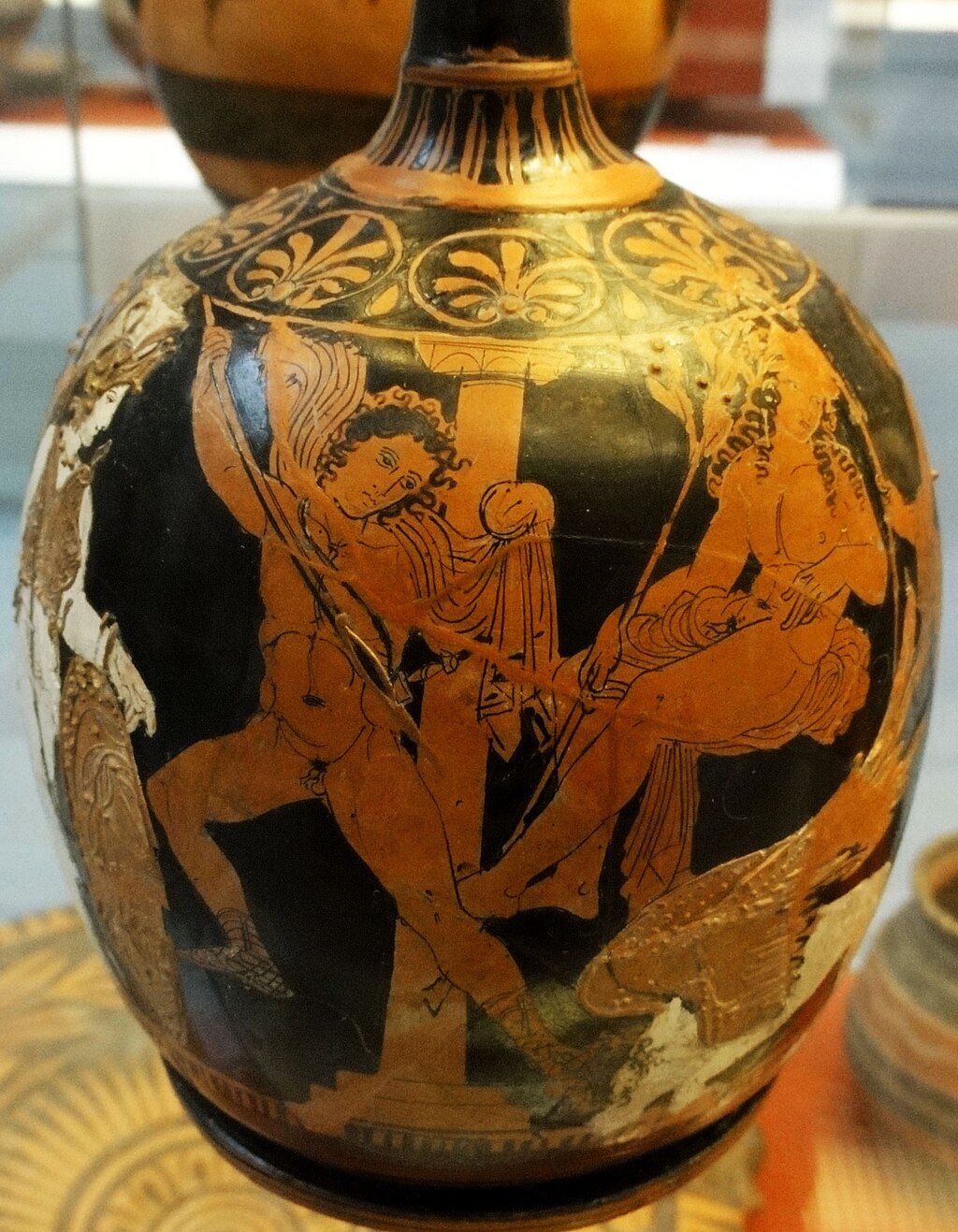 Oedipus slaying the sphinx Most, if not all, of our knowledge of Oedipus, comes from the 5th century BC. Though these stories principally deal with his downfall, various details still appear on how Oedipus rose to power. King Laius of Thebes hears of a prophecy that his infant son will one day kill him.[2] He pierces Oedipus' feet and leaves him out to die, but a shepherd finds him and carries him away.[3] Years later, Oedipus, not knowing he was adopted, leaves home in fear of the same prophecy that he will kill his father and marry his mother.[4] Laius journeys out to seek a solution to the Sphinx's mysterious riddle.[5] As prophesied, Oedipus and Laius cross paths, but they do not recognize each other. A fight ensues, and Oedipus kills Laius and most of his guards.[6] Oedipus goes on to defeat the Sphinx by solving a riddle to become king.[7] He marries the widowed Queen Jocasta, unaware that she is his mother. A plague falls on the people of Thebes. Upon discovering the truth, Oedipus blinds himself, and Jocasta hangs herself.[8] After Oedipus is no longer king, Oedipus's brother-sons kill each other. Some differences with older stories emerge. The curse of Oedipus' sons was elaborated on retroactively to include Oedipus and his father, Laius. Oedipus now steps down from the throne instead of dying in battle. Additionally, rather than his children being by a second wife, Oedipus's children are now by Jocasta (hence, they are his brothers as well). Pindar's second Olympian Ode In his second Olympian Ode, Pindar writes:[9] Laius' tragic son, crossing his father's path, killed him and fulfilled the oracle spoken of old at Pytho. And sharp-eyed Erinys saw and slew his warlike children at each other's hands. Yet Thersandros survived fallen Polyneikes and won the honor in youthful contests and the brunt of war, a scion of aid to the house of Adrastos. Aeschylus' Seven Against Thebes trilogy (467 BC) In 467 BC, the Athenian playwright, Aeschylus, most notably wrote a trilogy based on the myth of Oedipus, winning him the first prize at the City Dionysia. Of the plays, Laius was the first, Oedipus was second, and Seven Against Thebes was the third play and the only one to have survived. In Seven Against Thebes, Oedipus's sons Eteocles and Polynices kill each other warring over the throne. Much like his Oresteia, the trilogy would have detailed the tribulations of a House over three successive generations. The satyr play that followed the trilogy was called The Sphinx. Sophocles' Theban plays The three surviving works of Sophocles' "Theban plays" consist of: Oedipus Rex (also called Oedipus Tyrannus or Oedipus the King), Oedipus at Colonus, and Antigone. All three plays concern the fate of the City of Thebes, during and after the reign of King Oedipus,[10] and have often been published under a single cover.[11] Originally, Sophocles had written the plays for three separate festival competitions, many years apart. Not only are the Theban plays not a true trilogy (three plays presented as a continuous narrative), they are not even an intentional series and contain some inconsistencies among them.[10] Sophocles also wrote other plays focused on Thebes, most notably the Epigoni, of which only fragments have survived.[12] Oedipus Rex As Sophocles' Oedipus Rex begins, the people of Thebes are begging the king for help, begging him to discover the cause of the plague. Oedipus stands before them and swears to find the root of their suffering and to end it. Just then, Creon returns to Thebes from a visit to the oracle. Apollo has made it known that Thebes is harboring a terrible abomination and that the plague will only be lifted when the true murderer of old King Laius is discovered and punished for his crime. Oedipus swears to do this, not realizing that he is himself the culprit. The stark truth emerges slowly over the course of the play, as Oedipus clashes with the blind seer Tiresias, who senses the truth. Oedipus remains in strict denial, though, becoming convinced that Tiresias is somehow plotting with Creon to usurp the throne. Realization begins to slowly dawn in Scene II of the play when Jocasta mentions out of hand that Laius was slain at a place where three roads meet. This stirs something in Oedipus's memory and he suddenly remembers the men he fought and killed one day long ago at a place where three roads met. He realizes, horrified, that he might be the man he's seeking. One household servant survived the attack and now lives out his old age in a frontier district of Thebes. Oedipus sends immediately for the man to either confirm or deny his guilt. At the very worst, though, he expects to find himself to be the unsuspecting murderer of a man unknown to him. The truth has not yet been made clear. The moment of epiphany comes late in the play. At the beginning of Scene III, Oedipus is still waiting for the servant to be brought into the city, when a messenger arrives from Corinth to declare that King Polybus of Corinth is dead. Oedipus, when he hears this news, feels much relieved, because he believed that Polybus was the father whom the oracle had destined him to murder, and he momentarily believes himself to have escaped fate. He tells this all to the present company, including the messenger, but the messenger knows that it is not true. He is the man who found Oedipus as a baby in the pass of Cithaeron and gave him to King Polybus to raise. He reveals, furthermore that the servant who is being brought to the city as they speak is the very same man who took Oedipus up into the mountains as a baby. Jocasta realizes now all that has happened. She begs Oedipus not to pursue the matter further. He refuses, and she withdraws into the palace as the servant is arriving. The old man arrives, and it is clear at once that he knows everything. At the behest of Oedipus, he tells it all. Overwhelmed with the knowledge of all his crimes, Oedipus rushes into the palace where he finds his mother-wife, dead by her own hand. Ripping a brooch from her dress, Oedipus blinds himself with it. Bleeding from the eyes, he begs his uncle and brother-in-law Creon, who has just arrived on the scene, to exile him forever from Thebes. Creon agrees to this request. Oedipus begs to hold his two daughters Antigone and Ismene with his hands one more time to have their eyes full of tears and Creon out of pity sends the girls in to see Oedipus one more time. Oedipus at Colonus 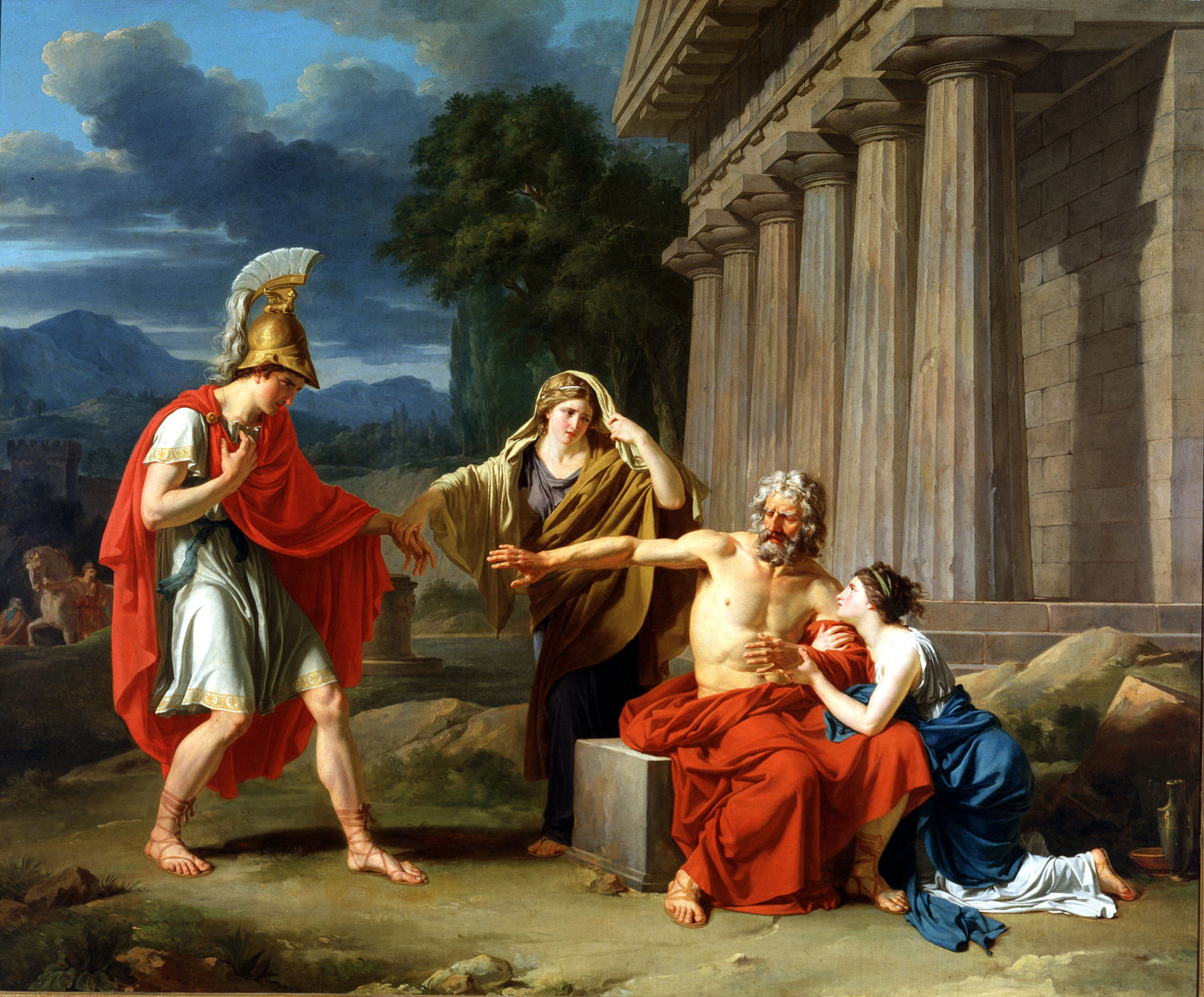 Oedipus at Colonus In Sophocles' Oedipus at Colonus, Oedipus becomes a wanderer, pursued by Creon and his men. He finally finds refuge in the holy wilderness right outside Athens, where it is said that Theseus took care of Oedipus and his daughter, Antigone. Creon eventually catches up to Oedipus. He asks Oedipus to come back from Colonus to bless his son, Eteocles. Angry that his son did not love him enough to take care of him, he curses both Eteocles and his brother, condemning them both to kill each other in battle. Oedipus dies a peaceful death; his grave is said to be sacred to the gods. Antigone 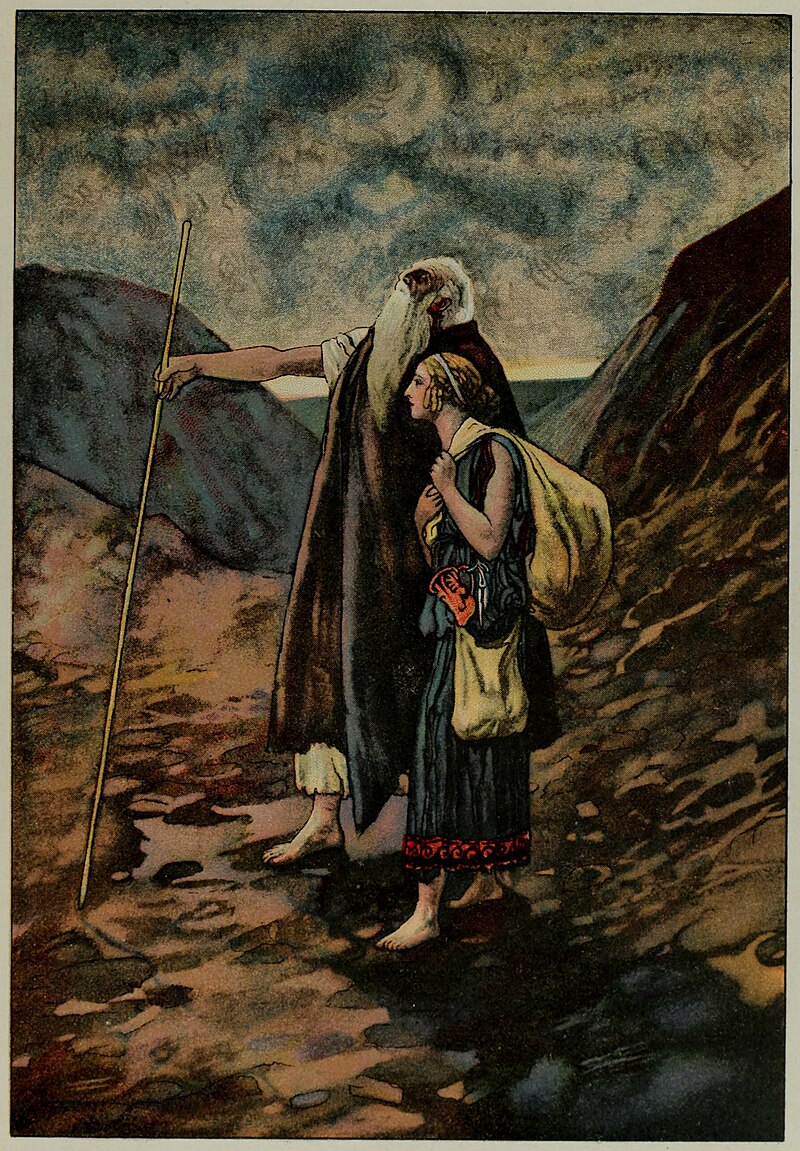 The blind Oedipus led by his daughter Antigone In Sophocles' Antigone, when Oedipus stepped down as king of Thebes, he gave the kingdom to his two sons, Eteocles and Polynices, both of whom agreed to alternate the throne every year. However, they showed no concern for their father, who cursed them for their negligence. After the first year, Eteocles refused to step down and Polynices attacked Thebes with his supporters (as portrayed in the Seven Against Thebes by Aeschylus and the Phoenician Women by Euripides). The two brothers killed each other in battle. King Creon, who ascended to the throne of Thebes, decreed that Polynices was not to be buried. Antigone, Polynices' sister, defied the order but was caught. Creon decreed that she was to be put into a stone box in the ground, this in spite of her betrothal to his son Haemon. Antigone's sister, Ismene, then declared she had aided Antigone and wanted the same fate, but Creon eventually declined to execute her. The gods, through the blind prophet Tiresias, expressed their disapproval of Creon's decision, which convinced him to rescind his order, and he went to bury Polynices himself. However, Antigone had already hanged herself in her tomb, rather than suffering the slow death of being buried alive. When Creon arrived at the tomb where she had been interred, his son Haemon attacked him upon seeing the body of his deceased fiancée but failing to kill Creon he killed himself. When Creon's wife, Eurydice, was informed of the death of Haemon, she too took her own life. Euripides' Phoenissae, Chrysippus, and Oedipus At the beginning of Euripides' Phoenissae, Jocasta recalls the story of Oedipus. Generally, the play weaves together the plots of the Seven Against Thebes and Antigone. The play differs from the other tales in two major respects. First, it describes in detail why Laius and Oedipus had a feud: Laius ordered Oedipus out of the road so his chariot could pass, but proud Oedipus refused to move. Second, in the play Jocasta has not killed herself at the discovery of her incest – otherwise, she could not play the prologue, for fathomable reasons – nor has Oedipus fled into exile, but they have stayed in Thebes only to delay their doom until the fatal duel of their sons/brothers/nephews Eteocles and Polynices: Jocasta commits suicide over the two men's dead bodies, and Antigone follows Oedipus into exile. In Chrysippus, Euripides develops backstory on the curse: Laius' sin was to have kidnapped Chrysippus, Pelops' son, in order to violate him, and this caused the gods' revenge on all his family. Laius was the tutor of Chrysippus, and raping his student was a severe violation of his position as both guest and tutor in the house of the royal family hosting him at the time. Extant vases show a fury hovering over the lecherous Laius as he abducts the rape victim.[13] Furies avenged violations of good order in households, as can be seen most clearly in such texts as The Libation Bearers by Aeschylus. Euripides wrote also an Oedipus, of which only a few fragments survive.[14] The first line of the prologue recalled Laius' hubristic action of conceiving a son against Apollo's command. At some point in the action of the play, a character engaged in a lengthy and detailed description of the Sphinx and her riddle – preserved in five fragments from Oxyrhynchus, P.Oxy. 2459 (published by Eric Gardner Turner in 1962).[15] The tragedy also featured many moral maxims on the theme of marriage, preserved in the Anthologion of Stobaeus. The most striking lines, however, state that in this play Oedipus was blinded by Laius' attendants and that this happened before his identity as Laius' son had been discovered, therefore marking important differences with the Sophoclean treatment of the myth, which is now regarded as the 'standard' version. Many attempts have been made to reconstruct the plot of the play, but none of them is more than hypothetical, because of the scanty remains that survive from its text and of the total absence of ancient descriptions or résumés – though it has been suggested that a part of Hyginus' narration of the Oedipus myth might in fact derive from Euripides' play. Some echoes of the Euripidean Oedipus have been traced also in a scene of Seneca's Oedipus (see below), in which Oedipus himself describes to Jocasta his adventure with the Sphinx.[16] Other playwrights At least three other 5th-century BC authors who were younger than Sophocles wrote plays about Oedipus. These include Achaeus of Eretria, Nichomachus and the elder Xenocles.[17] Later additions The Bibliotheca, a Roman-era mythological handbook, includes a riddle for the Sphinx, borrowing the poetry of Hesiod: What is that which has one voice and yet becomes four-footed and two-footed and three-footed?[18] Later addition to Aeschylus' Seven against Thebes Due to the popularity of Sophocles's Antigone (c. 442 BC), the ending (lines 1005–78) of Seven against Thebes was added some fifty years after Aeschylus' death.[19] Whereas the play (and the trilogy of which it is the last play) was meant to end with somber mourning for the dead brothers, the spurious ending features a herald announcing the prohibition against burying Polynices, and Antigone's declaration that she will defy that edict. Post-Classical literature Oedipus was a figure who was also used in the Latin literature of ancient Rome. Julius Caesar wrote a play on Oedipus, but it has not survived into modern times.[20] Ovid included Oedipus in Metamorphoses, but only as the person who defeated the Sphinx. He makes no mention of Oedipus's troubled experiences with his father and mother. Seneca the Younger wrote his own play on the story of Oedipus in the first century AD. It differs in significant ways from the work of Sophocles. Some scholars have argued that Seneca's play on the myth was intended to be recited at private gatherings and not actually performed. It has however been successfully staged since the Renaissance. It was adapted by John Dryden in his very successful heroic drama Oedipus, licensed in 1678. The 1718 Oedipus was also the first play written by Voltaire. A version of Oedipus by Frank McGuinness was performed at the National Theatre in late 2008, starring Ralph Fiennes and Claire Higgins. In the late 1960s Ola Rotimi published a novel and play, The Gods Are Not To Blame, which retell the Oedipus myth happening in the Yoruba kingdom.[21] In 2011, U.S. writer David Guterson published his Oedipus-inspired novel "Ed King".[citation needed] In folkloristics, the myth of Oedipus is classified in the international Aarne-Thompson-Uther Index as tale type ATU 931, "Oedipus".[22][23][24] |
古代の資料(紀元前5世紀) スフィンクスを倒すオイディプス オイディプスに関する私たちの知識は、すべてではないにせよ、そのほとんどが紀元前5世紀のものである。これらの物語は主にオイディプスの没落を描いているが、オイディプスがどのようにして権力を握ったのか、様々な詳細が残されている。 テーベのライオス王は、幼い息子がいつか自分を殺すという予言を聞き、オイディプスの足を刺して死なせるが、羊飼いに見つかり、連れ去られる[3]。 [3] 数年後、オイディプスは自分が養子であることを知らず、父親を殺して母親と結婚するという同じ予言を恐れて家を出る。オイディプスは謎を解くことでスフィ ンクスを倒し、王になる。テーベの人々に災いが降りかかる。オイディプスが王でなくなった後、オイディプスの兄弟の息子たちは互いに殺しあう。 古い物語との違いもいくつか出てくる。オイディプスの息子たちの呪いは、オイディプスとその父ライオスを含むように遡及的に精緻化された。オイディプスは 戦死する代わりに王座から退く。さらに、オイディプスの子供たちは、後妻との間にできた子供たちではなく、ジョカスタとの間にできた子供たちである(した がって、彼らは彼の兄弟でもある)。 ピンダルの第二オリンポスの頌歌 ピンダルは第二のオリンポスの頌歌で次のように書いている[9]。 ライオスの悲劇の息子は、父の道を横切り、父を殺し、ピュトで昔から語られていた神託を成就させた。そして、鋭い目をしたエリニスは、彼の戦いの好きな子 供たちが互いの手で殺されるのを見た。しかし、テュルサンドロスは倒れたポリネイケスを生き延び、若者のコンテストで栄誉を勝ち取り、アドラストス家を助 ける子孫として戦争の矢面に立った。 アイスキュロスの『テーベに対する七人』三部作(紀元前467年) 紀元前467年、アテナイの劇作家アイスキュロスは、オイディプスの神話に基づく三部作を書き、都市ディオニュシアで一等賞を受賞した。ライオス』が第一作、『オイディプス』が第二作、『テーベに対する七人』が第三作で、現存する唯一の作品である。 テーベに対する七人』では、オイディプスの息子エテオクレスとポリュニケスが王位をめぐって殺し合う。オイディプスの『オレステイア』と同様、この三部作は、三代にわたる一族の苦難を詳細に描いたものである。三部作に続くサテュロス劇は『スフィンクス』と呼ばれた。 ソフォクレスのテーバン劇 現存するソフォクレスの「テーバン劇」は以下の3作品からなる: オイディプス王』(『オイディプス・ティラノス』または『王オイディプス』とも呼ばれる)、『コロノスのオイディプス』、『アンティゴネー』である。3つ の戯曲はすべて、オイディプス王の治世中と治世後のテーベ市の運命に関わるものであり[10]、しばしば1つの表紙で出版されている[11]。 もともとソフォクレスは、何年も離れた3つの祭りのコンテストのために戯曲を書いた。テーバン戯曲は真の三部作(3つの戯曲が連続した物語として上演される)ではないだけでなく、意図的なシリーズですらなく、戯曲間にはいくつかの矛盾がある[10]。 ソフォクレスはテーベに焦点を当てた他の戯曲も書いており、特にエピゴーニは断片しか残っていない[12]。 オイディプス王 ソフォクレスの『オイディプス王(Oedipus Rex)』が始まると、テーベの人々は王に助けを求め、疫病の原因を突き止めるよう懇願する。オイディプスは彼らの前に立ちはだかり、苦しみの根源を見つ け出し、それを終わらせると誓う。その時、クレオンが神託を受けにテーベに戻る。アポロンは、テーベには恐ろしい忌まわしいものが潜んでおり、疫病は老い たライオス王を殺した真犯人が発見され、その罪が罰せられることで初めて収まると告げた。オイディプスは、自分自身が犯人であることに気づかないまま、そ のことを誓う。オイディプスが真実を察知した盲目の予見者ティレジアスと衝突する中で、厳然たる真実が劇の過程で徐々に浮かび上がってくる。しかしオイ ディプスは、ティレジアスがクレオンと組んで王位簒奪を企んでいると確信し、厳格に否定し続ける。 劇の第2場で、ジョカスタがライオスが3つの道が交わる場所で殺されたことを唐突に口にしたとき、そのことに徐々に気づき始める。これによってオイディプ スの記憶に何かが呼び起こされ、彼は突然、遠い昔のある日、3つの道が交わる場所で戦って殺した男たちのことを思い出す。オイディプスは愕然としながら、 自分が探している男かもしれないと気づく。一人の家僕がその襲撃から生き延び、今はテーベの辺境地区で老後を過ごしている。オイディプスはすぐにその男の もとを訪れ、罪を認めるか否かを問う。しかし、最悪の場合、オイディプスは自分が見知らぬ男の殺人犯であることを知ることになる。真実はまだ明らかになっ ていない。 啓示の瞬間は劇の後半に訪れる。第III場冒頭、オイディプスがまだ召使いを待っていると、コリントから使者がやってきて、コリントのポリバス王が死んだ と告げる。この知らせを聞いたオイディプスは、ポリュバスが神託によって殺される運命にあった父親だと信じていたので、大いに安堵し、自分は運命から逃れ られたと一瞬思う。彼はこのことを、使者を含む現在の仲間にすべて話したが、使者はそれが真実でないことを知っていた。彼はシタエロンの峠で赤ん坊のオイ ディプスを見つけ、ポリュバス王に渡して育ててもらった男なのだ。さらに彼は、二人が話している間に都に連れてこられた召使いが、赤ん坊のオイディプスを 山に連れて行った男そのものであることを明かす。ジョカスタは今、すべての出来事に気づく。彼女はオイディプスに、これ以上この問題を追及しないでほしい と懇願する。彼はそれを拒み、彼女は使用人が到着するのを見計らって宮殿に引き下がる。老人が到着し、彼がすべてを知っていることはすぐにわかった。オイ ディプスの求めに応じて、老人はすべてを話す。 オイディプスは自分の罪のすべてを知って圧倒され、宮殿に駆け込む。彼女のドレスからブローチをはぎ取り、オイディプスはそのブローチで自分の目をつぶ す。目から血を流しながら、オイディプスは叔父で義兄のクレオンに、自分をテーベから永遠に追放してほしいと懇願する。クレオンはこれを承諾する。オイ ディプスは、二人の娘アンティゴネとイスメネをもう一度両手で抱いて、その目に涙を溢れさせてほしいと懇願し、クレオンは憐れみから、娘たちをもう一度オ イディプスに会わせる。 コロンヌスのオイディプス  コロンヌスのオイディプス ソフォクレスの『コロヌスのオイディプス』では、オイディプスはクレオンとその部下に追われ、放浪の旅に出る。彼はアテネ郊外のテセウスがオイディプスと その娘アンティゴネを保護したと言われる聖なる荒野に避難する。やがてクレオンはオイディプスに追いつく。息子エテオクレスを祝福するため、オイディプス にコロヌスから戻るよう求める。息子が自分の面倒を見るほど自分を愛していなかったことに腹を立てたクレオンは、エテオクレスとその弟の二人を呪い、戦い で殺し合うよう宣告する。オイディプスは安らかな死を迎え、その墓は神々にとって神聖なものとされる。 アンチゴーヌ  娘アンティゴネーに導かれた盲目のオイディプス ソフォクレスの『アンティゴネー』では、オイディプスがテーベの王を退くと、王国を二人の息子エテオクレスとポリュニケスに譲り、二人は毎年王位を交代す ることに同意した。しかし、二人は父を顧みず、その怠慢を罵られた。1年目の後、エテオクレスは退位を拒否し、ポリュニケスは支持者たちとともにテーベを 攻撃した(『テーベに対する七人』(アイスキュロス作)や『フェニキアの女たち』(エウリピデス作)に描かれている)。二人の兄弟は戦いの中で殺しあっ た。テーベの王位に就いたクレオン王は、ポリュニケスを埋葬してはならないと命じた。ポリュニクスの妹であるアンティゴネはその命令に背いたが、捕まって しまった。クレオンは、彼女が息子のヘーモンと婚約しているにもかかわらず、彼女を土の中の石の箱に入れるよう命じた。アンティゴネの妹イスメネもアン ティゴネに協力し、同じ運命を望むと宣言したが、クレオンは結局彼女の処刑を断念した。神々は盲目の預言者ティレシアスを通してクレオンの決定に反対を表 明し、クレオンは命令を取り消すよう説得され、自らポリニスを埋葬しに行った。しかし、アンティゴネは生き埋めという緩慢な死ではなく、すでに墓の中で首 を吊っていた。彼女が埋葬された墓に到着したクレオンは、亡き婚約者の遺体を見て息子のヘーモンに襲われたが、クレオンを殺すことができずに自害した。ク レオンの妻エウリュディケは、ハーモンの死を知らされ、自ら命を絶った。 エウリピデスの『フェニサエ』、クリシッポス、オイディプス エウリピデスの『フェニサエ』の冒頭で、ジョカスタはオイディプスの物語を回想する。一般に、この戯曲は『テーベに対する七人』と『アンティゴネー』のプ ロットを織り交ぜている。この戯曲が他の物語と異なる点は大きく2つある。第一に、ライオスとオイディプスが確執を抱いた理由が詳細に描かれている: ライオスはオイディプスに、自分の馬車が通れるように道路に出るように命じたが、高慢なオイディプスは動こうとしなかった。第二に、劇中ではジョカスタは 近親相姦の発覚で自殺したわけではなく、そうでなければプロローグを演じることができない: ジョカスタは二人の死体の上で自殺し、アンティゴネはオイディプスの後を追って亡命する。 エウリピデスは『クリシッポス』の中で、呪いに関する裏話を展開している: ライオスの罪は、ペロプスの息子クリシッポスを誘拐して乱暴したことであり、そのために神々は彼の家族全員に復讐した。ライオスはクリシッポスの家庭教師 であり、教え子を犯すことは、当時彼を迎えていた王家の客人であり家庭教師でもあった彼の立場に対する重大な違反であった。現存する壷には、強姦の被害者 を拉致した淫乱なライオスの上に怒りが漂っている様子が描かれている。 エウリピデスは『オイディプス』も書いているが、その断片はわずかしか残っていない[14]。プロローグの最初の行は、アポロンの命に反して息子を身ご もったライオスの思い上がった行動を想起させる。戯曲のアクションのある時点で、登場人物がスフィンクスとその謎かけについて長く詳細な描写を行ったが、 これはOxyrhynchus, P.Oxy. 2459(1962年にエリック・ガードナー・ターナーによって出版された)[15] また、この悲劇には結婚をテーマとした道徳的な格言が数多く登場し、『ストバイオスのアンソロジオン』に残されている。しかし、最も印象的な台詞は、この 劇においてオイディプスはライオスの従者によって失明させられたこと、そしてそれがライオスの息子であることが判明する前に起こったことである。この戯曲 のプロットを再構築しようとする試みは数多くなされているが、そのどれもが仮説以上のものにはなっていない。というのも、この戯曲のテキストに残っている 遺物は乏しく、古代の記述や履歴書がまったく残っていないからである。セネカの『オイディプス』(後述)の一場面で、オイディプス自身がスフィンクスとの 冒険をヨカスタに語る場面にも、エウリピデスの『オイディプス』の反響が見られる[16]。 他の劇作家 ソフォクレスよりも若い紀元前5世紀の作家が、オイディプスを題材にした戯曲を書いている。その中にはエレトリアのアカイオス、ニコマコス、長老クセノクレスが含まれる[17]。 後の追加 ローマ時代の神話ハンドブックであるBibliothecaには、ヘシオドスの詩を借用したスフィンクスの謎かけがある: 一声でありながら、四足になり、二足になり、三足になるものは何か? 後に追加されたアイスキュロスの『テーベに対する七人 ソフォクレスの『アンティゴネー』(紀元前442年頃)の人気のため、『テーベに対す る七人』のエンディング(1005行目から78行目)は、アイスキュロスの死後50年ほど経ってから追加された[19]。この戯曲(と、この戯曲を最後と する三部作)は、死んだ兄弟を悼む厳かな雰囲気で終わる予定であったのに対し、偽のエンディングでは、ポリニスを埋葬することの禁止を告げる前触れと、そ の勅令に反抗するというアンティゴネの宣言が登場する。 古典期以降の文学 オイディプスは古代ローマのラテン文学にも登場する人物である。ユリウス・カエサルはオイディプスを題材にした戯曲を書いたが、現代には残っていない [20]。オウィッドは『メタモルフォーゼ』にオイディプスを登場させたが、それはスフィンクスを倒した人物としてだけである。彼はオイディプスの父と母 との問題体験については言及していない。若き日のセネカは、紀元1世紀にオイディプスの物語を題材にした自作の戯曲を書いた。それはソフォクレスの作品と は重要な点で異なっている。 一部の学者は、セネカの神話劇は個人的な集まりで朗読されることを意図したものであり、実際に上演されることはなかったと主張している。しかし、ルネサン ス期以降、上演は成功した。ジョン・ドライデンが脚色し、1678年に上演を許可された英雄劇『オイディプス』は大成功を収めた。1718年の『オイディ プス』は、ヴォルテールが初めて書いた戯曲でもある。フランク・マクギネスによる『オイディプス』は、2008年末にラルフ・ファインズとクレア・ヒギン ズ主演でナショナル・シアターで上演された。 1960年代後半、オラ・ロティミは、ヨルバ王国で起こったオイディプス神話を再現した小説と戯曲『神々に罪はない』を出版した[21]。 2011年には米国の作家デヴィッド・グターソンがオイディプスにインスパイアされた小説『エド・キング』を出版した[要出典]。 民俗学では、オイディプスの神話は国際的なアーン・トンプソン・ウザー・インデックスにおいて物語タイプATU 931「オイディプス」として分類されている[22][23][24]。 |
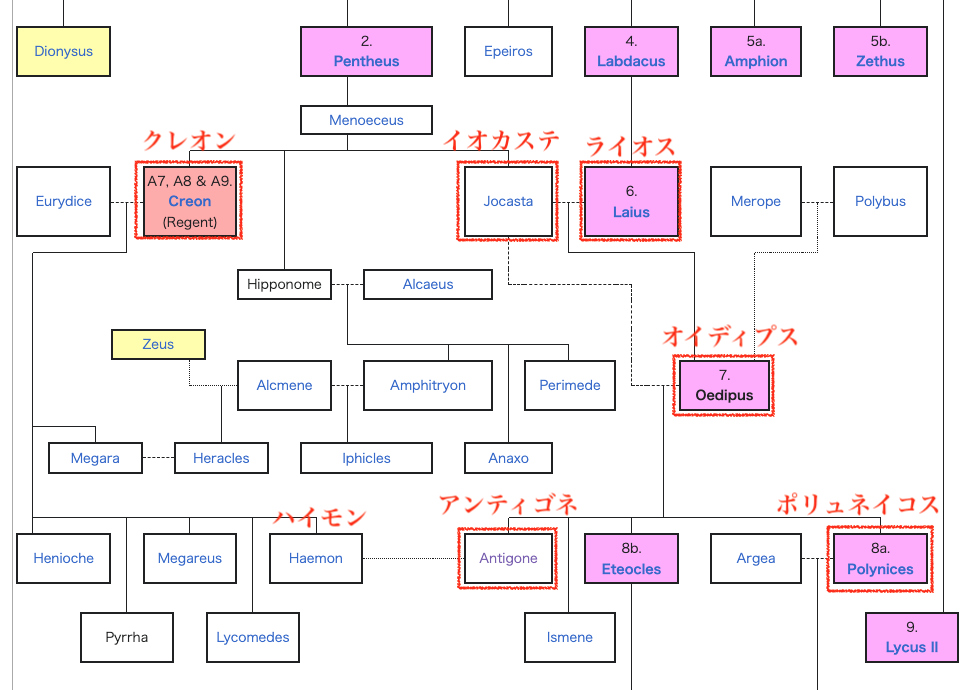 |

|
| Oedipus complex Main article: Oedipus complex Sigmund Freud used the name "the Oedipus complex" to explain the origin of certain neuroses in childhood. It is defined as a male child's unconscious desire for the exclusive love of his mother. This desire includes jealousy towards the father and the unconscious wish for that parent's death, as well as the unconscious desire for sexual intercourse with the mother. Oedipus himself, as portrayed in the myth, did not have this neurosis – at least, not towards Jocasta, whom he only met as an adult (if anything, such feelings would have been directed at Merope – but there is no hint of that). Freud reasoned that the ancient Greek audience, which heard the story told or saw the plays based on it, did know that Oedipus was actually killing his father and marrying his mother; the story being continually told and played therefore reflected a preoccupation with the theme.[25] |
エディプス・コンプレックス 主な記事 エディプス・コンプレックス ジークムント・フロイトは、小児期のある種の神経症の起源を説明するために「エディプス・コンプレックス」という名前を使った。エディプス・コンプレック スとは、男児が無意識のうちに抱く、母親からの独占的な愛を求める欲求と定義される。この欲望には、父親に対する嫉妬や、その親の死を無意識に願うこと、 母親との性交を無意識に望むことも含まれる。神話に描かれたオイディプス自身は、このような神経症は持っていなかった--少なくとも、大人になってから出 会ったジョカスタに対しては(どちらかといえば、そのような感情はメロペに向けられていたはずだが、そのような気配はない)。フロイトは、この物語が語ら れるのを聞いたり、それに基づいた劇を見たりした古代ギリシアの観客は、オイディプスが実際に父親を殺して母親と結婚していることを知っていた。 |
| Epigoni Genetic attraction Myrrha (the Greek myth of incestual love between father and daughter) Lille Stesichorus |
エピゴーニ 遺伝的魅力 ミルラ(父と娘の近親愛のギリシャ神話) リール・ステシコーラス |
| https://en.wikipedia.org/wiki/Oedipus |
|

★アンティゴネーとクレオンの関係(→「ヘーゲルとアンティゴネー」)

リ ンク
文 献
そ の他の情報
Copyleft, CC, Mitzub'ixi Quq Chi'j, 1996-2099
☆
 ☆
☆